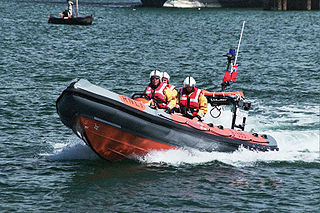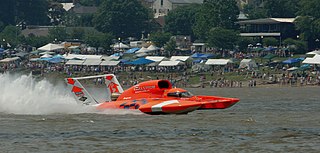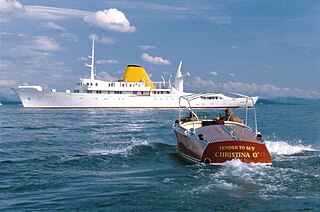
An outboard motor is a propulsion system for boats, consisting of a self-contained unit that includes engine, gearbox and propeller or jet drive, designed to be affixed to the outside of the transom. They are the most common motorised method of propelling small watercraft. As well as providing propulsion, outboards provide steering control, as they are designed to pivot over their mountings and thus control the direction of thrust. The skeg also acts as a rudder when the engine is not running. Unlike inboard motors, outboard motors can be easily removed for storage or repairs.
A skeg is a sternward extension of the keel of boats and ships which have a rudder mounted on the centre line. The term also applies to the lowest point on an outboard motor or the outdrive of an inboard/outboard. In more recent years, the name has been used for a fin on a surfboard which improves directional stability and to a movable fin on a kayak which adjusts the boat's centre of lateral resistance. The term is also often used for the fin on water skis in the U.S. It has been used for the vertical fin on seaplane hulls and floats. The wear-bar on the bottom of snowmobile ski may also be called a skeg.

A rigid inflatable boat (RIB), also rigid-hull inflatable boat or rigid-hulled inflatable boat (RHIB), is a lightweight but high-performance and high-capacity boat constructed with a rigid hull bottom joined to side-forming air tubes that are inflated with air to a high pressure so as to give the sides resilient rigidity along the boat's topsides. The design is stable, light, fast and seaworthy. The inflated collar acts as a life jacket, ensuring that the vessel retains its buoyancy, even if the boat is taking on water. The RIB is an evolutionary development of the inflatable boat with a rubberized fabric bottom that is stiffened with flat boards within the collar to form the deck or floor of the boat.

Boat building is the design and construction of boats — and their on-board systems. This includes at minimum the construction of a hull, with any necessary propulsion, mechanical, navigation, safety and other service systems as the craft requires.

A hydroplane is a fast motorboat, where the hull shape is such that at speed, the weight of the boat is supported by planing forces, rather than simple buoyancy.

Hydroplane racing is a sport involving racing hydroplanes on lakes, rivers, and bays. It is a popular spectator sport in several countries.

A motorboat, speedboat or powerboat is a boat that is exclusively powered by an engine.

A pump-jet, hydrojet, or water jet is a marine system that produces a jet of water for propulsion. The mechanical arrangement may be a ducted propeller, a centrifugal pump, or a mixed flow pump which is a combination of both centrifugal and axial designs. The design also incorporates an intake to provide water to the pump and a nozzle to direct the flow of water out of the pump.

A sterndrive or inboard/outboard drive (I/O) is a form of marine propulsion which combines inboard power with outboard drive. The engine sits just forward of the transom while the drive unit lies outside the hull.

A radio-controlled boat is a boat or ship model controlled remotely with radio control equipment.

A yacht tender is a vessel used for servicing and providing support and entertainment to a private or charter yacht. They include utilitarian craft, powered by oar or outboard motor, and high-speed luxury craft, supporting superyachts, powered by inboard engines, some using water-jets. Some superyachts have a support vessel that follows them with bulky items that are not conveniently stowed aboard the main yacht, such as a helicopter, automobile or larger watercraft.

An inboard motor is a marine propulsion system for boats. As opposed to an outboard motor where an engine is mounted outside the hull of the craft, an inboard motor is an engine enclosed within the hull of the boat, usually connected to a propulsion screw by a driveshaft.

The Thompson Brothers Boat Manufacturing Company of Peshtigo, Wisconsin was a manufacturer of pleasure boats and canoes. Founded by brothers Peter and Christ Thompson in 1904, the company became prominent in the field and built boats for nearly one hundred years. The Thompson Antique & Classic Boat Rally celebrates the company's history with a boat show every other year and in 2013 the Thompson Brothers canoe was celebrated at the Annual Assembly of the Wooden Canoe Heritage Association.

Hacker-Craft is the name given to boats built by The Hacker Boat Co., an American manufacturer founded in Detroit, Michigan, in 1908 by John L. Hacker (1877–1961). It is one of the oldest constructors of wooden motor boats in the world. The company moved operations to New York State in the 1970s and continues to produce hand-built boats.
The Parker Dawson 26 is an American trailerable sailboat that was designed by Robert Finch as a cruiser and first built in 1972.
The Watkins 25, also known as the W25 and marketed as the Seawolf 25 from 1986, is an American trailerable sailboat that was designed by the Watkins Design Team and first built in 1983.
The Allegra 24 is an American trailerable sailboat that was designed by Fred Bingham and Lou Nagy and based upon the work of Fred Bingham's son, Bruce Bingham. The boat is intended as a cruiser and was first built in 1984.
The Eastsail 25 is an American trailerable sailboat that was designed by Eliot Spalding as an off-shore cruiser and first built in 1984.
The Kaiser 25 is an American trailerable sailboat that was designed by John R. Kaiser Sr. as a cruiser and first built in 1962.
The Lynx 16 is an American trailerable sailboat that was designed by Tony Davis as an daysailer and pocket cruiser, and first built in 1997.
















